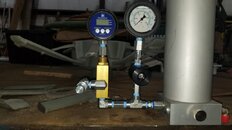I have to echo @rjack321 on this: you’ve created a fairly ugly duckling, when, in your own words, 99% of the time there is no reason for you to have done so. But maybe, just in case, on the off chance of an unlikely activity, you’ve added a great deal of… weirdness.
For example, you’re adding tees and caps and other fittings for the possibility of dealing with pure oxygen down the road, just to save the purchase price of a single gauge. That causes me to cringe badly for two reasons: one, when you’re dealing with pure oxygen, it’s a really good idea to be careful and rigorous in how you’re doing so, not just adding pure 02 to a random collection of fittings. And two, you’re making some thing that you’re hoping to use regularly a great deal more cumbersome to use, because of something you’re not even certain exactly what or how you will use.
You’ve told us in the past, you’re a long-time expert with high pressure gas, so you do you. I am the opposite of an expert in dealing with high-pressure gas. Maybe that’s why I tend to try to aim for a higher standard: I don’t know what risks can be taken safely, so I tend to take fewer risks.
But that is not a collection of fittings that I would be proud of, nor would it be something I would be targeting as a a usable result. Not because it can’t work: it probably will work. I just don’t like a lot of “probably“ when dealing with high-pressure gas. Let alone the idea of then extending that with pure oxygen.
I appreciate you taking the time to respond and your insight.
The T and plug under the digital gauge is for O2 later.... not a big deal to remove. The T with caps on the other side of the PMV is for 2 separate whips that are not installed yet, just easier to work without hoses for now. I have caps hand tight to avoid damaging the threads on the fittings. They will get tied directly to each. I wanted 2 whips so I can leave the compressor running and swap between tanks and keep things moving.
Each gauge has JIC fittings to be easily removed. The digital gauge and the gauge at the tower will most likely stay, the other gauges will most likely be removed and capped (I believe Ian had mentioned to do it this way? Someone earlier in this thread did). I just needed a baseline for when the compressor starts to act up later down the road.
No Sir, never did I say I'm an expert on high pressure gases, not once, not ever. My first post and many in this thread state my lack of experience. The only thing that I have any knowledge of is propane and I don't consider myself an expert, always learning, and I wouldn't even consider propane a high pressure gas. This is my fist attempt at a compressor, my first attempt with high pressure fittings. I'm really just learning.




